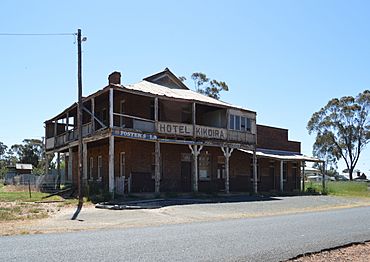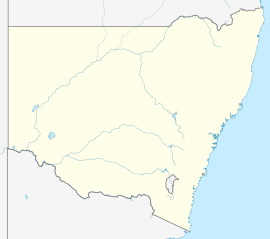Kikoira facts for kids
Quick facts for kids KikoiraNew South Wales |
|
|---|---|

Kikoira Hotel, now closed
|
|
| Postcode(s) | 2669 |
| Location | |
| LGA(s) | Bland Shire |
| State electorate(s) | Cootamundra |
| Federal Division(s) | Riverina |
Kikoira is a small town in the Central West region of New South Wales, Australia. It's located about 548 kilometers (340 miles) west of Sydney, the state capital. Kikoira is part of the Bland Shire local government area.
The land around Kikoira is mainly used for farming. Farmers here grow wheat and raise sheep for wool. From 1939 to 1970, Kikoira was also famous for having one of Australia's biggest tin deposits.
Contents
How Kikoira Started
Soldier Settlement and Railway
After World War I, the Kikoira area was set aside for soldier settlement. This meant that land was given to soldiers returning from the war so they could start farms.
The railway line reached Kikoira in 1929. This was a big deal because it made it easier to transport farm products like wheat. Farms along the new railway line were then offered for sale. These farms were for "farmer's sons, wheatgrowers and landseekers generally."
Early Town Life
By 1931, the Kikoira district was growing. It even had its own rugby league team! A small school was also set up to teach the children. In 1933, the government built a large silo in Kikoira. This silo could hold 60,000 bushels of wheat. It helped farmers store and move their crops.
Around 1933, the first houses were built in the town itself. A public telephone was also installed, which was very important for communication back then. A branch of the Bank of New South Wales opened in 1935. The next year, a bush nursing hospital was built. This hospital provided medical care to people in the countryside.
In 1937, a newspaper called The Sydney Morning Herald reported that Kikoira was having a "building boom." This meant many new buildings were being constructed. An Australian rules football team was formed in 1938. The New South Wales Department of Education opened a public school in Kikoira in 1939.
Tin Mining in Kikoira
Discovery of Tin
In 1938, a gold miner named John Gibson came to Kikoira. He was looking for more gold. But instead of gold, he found a lot of tin. Tin is a metal used in many things, like cans and electronics.
Gibson quickly started a mine. By October 1938, his mine was already employing 21 workers. Soon, many people rushed to the area, hoping to find tin. By March 1939, a large area around Kikoira was marked out for mining.
Mining Boom and Gibsonvale
The mine kept growing. In 1940, it employed 140 workers! It was producing more tin than almost any other place in Australia, except for Tasmania. The newspaper described the settlement near the mine as a "scene unknown since the gold rush days." This new settlement was called Gibsonvale.
Some miners who found tin early became very rich. But others and their families lived in simple shelters called humpies. These were made from bark and wheat bags. The mining activity brought a lot of business to Kikoira. A famous soldier, Reg Rattey, who later won the Victoria Cross, worked at the Gibsonvale mine before World War II began.
Later Mining Years
Tin mining continued in the Kikoira area into the 1960s and 1970s. In 1968, a special plant was built at Gibsonvale to process the tin. This plant was designed to produce about 35 tonnes (34.4 long tons) of tin each month. It was expected to operate for about five years.
Several mines operated in the area, including:
- The Hills Mine (a tin mine)
- The Blairgowrie Mine (an underground gold mine)
- The Blackfellow Mine (an underground tin mine on Naradhan Road)
- Gibsonvale Kikoira Mine (an open-cut and underground tin mine off Naradhan Road)
- Christmas Gift Mine (an open-cut and underground tin mine just off Kikoira Road)
Kikoira Today
The Kikoira railway station closed in 1975. However, GrainCorp still operates a grain receival point in the town. This is where farmers bring their harvested grain. The Kikoira Hotel, which you can see in the picture, closed its doors in 1990.


